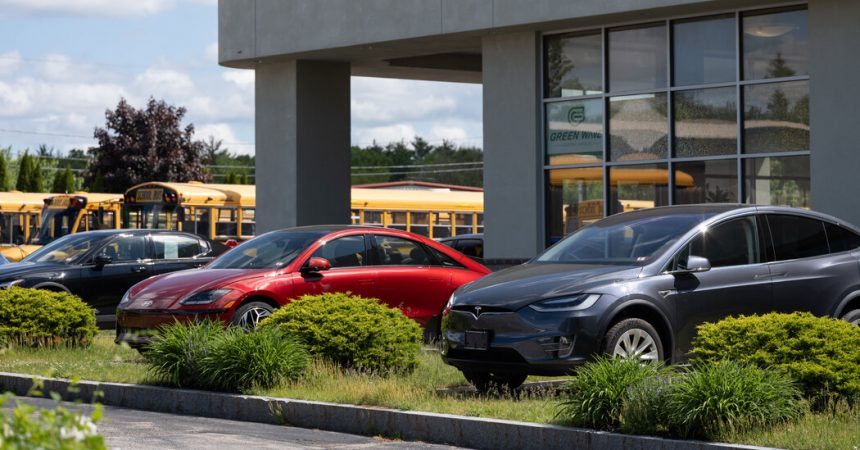Alex Lawrence, a dealer in Salt Lake City who specializes in used electric cars, has seen a change over the last year in the kinds of customers who are coming into his showroom. They used to be well-heeled professionals who could drop $70,000 on a Rivian luxury pickup truck.
Recently, Mr. Lawrence said, customers have been snapping up used Teslas for a little over $20,000, after applying a $4,000 federal tax credit.
“We’re seeing younger people,” Mr. Lawrence said. “We are seeing more blue-collar and entry-level white-collar people. The purchase price of the car has suddenly become in reach.”
Regarded by conservative politicians and other critics as playthings of the liberal elite, electric vehicles are fast becoming more accessible. Prices are falling because of increased competition, lower raw-material costs and more efficient manufacturing. Federal tax credits of up to $7,500 for new electric cars, often augmented by thousands of dollars in state incentives, push prices even lower.
At the same time, technology is improving quickly and making electric vehicles more practical. Cars that can travel more than 300 miles on a fully charged battery are becoming common, and charging times are dropping below 30 minutes. The number of fast chargers, which can top up a battery in less than half an hour, grew 36 percent from April 2023 to April 2024.
Carmakers including Tesla, Ford, General Motors and Stellantis, the owner of Jeep, have announced plans for electric vehicles that would sell new for as little as $25,000.
“The E.V. market has hit an inflection point,” said Randy Parker, chief executive of Hyundai Motor America, which will begin producing electric vehicles at a factory in Georgia by the end of the year. “The early adopters have come. They’ve got their cars. Now you’re starting to see us transition to a mass market.”
All this is good news for proponents of electric vehicles and the Biden administration, which is aiming for half of new cars sold to be electric by 2030 as part of the president’s plan to combat climate change. Even if Republicans gain control of the White House and Congress and follow through on promises to dismantle electric vehicle subsidies, they may not be able to undo the market forces pushing down prices.
“There may be some hiccups in the exact pace and scale of E.V. sales if there are major policy changes, but I wouldn’t expect the E.V. market to flatline,” said Peter Slowik, who leads research on passenger cars at the International Council on Clean Transportation, a research organization. “Most automakers are committed to an all-electric future, and many are planning on a timeline that goes far beyond the next administration.”
Electric cars, sales of which have slowed in recent months, are still more expensive than gasoline models, costing an average of $55,252 in the United States in April, according to estimates by Kelley Blue Book. That is a decline of 9 percent from April 2023, but still about $6,700 more than the average for all vehicles.
But Mr. Slowik’s group estimates that cars and sport-utility vehicles capable of traveling 400 miles on a full battery will cost less than cars with internal combustion engines in 2030, even before taking into account government subsidies. (Pickup trucks, which require bigger batteries, will take a little longer, not reaching parity for 400-mile models until 2033.)
Those calculations do not take into account lower fuel and maintenance costs that strengthen the financial argument for electric vehicles. Electricity is almost always cheaper per mile than gasoline, and battery-powered vehicles don’t need oil changes, engine air filters or spark plugs. For people who drive a lot, electric cars may already be a better deal. At the same time, some automakers are offering strong discounts on E.V. models as an enticement for buyers.
While prices are clearly trending downward, there are risks. China supplies more than half of the lithium-ion batteries used in cars sold in the United States, according to Interact Analysis, a research firm. Those batteries will become more expensive because the Biden administration announced in May that it would raise tariffs on them to 25 percent from 7.5 percent.
Many companies are building battery factories in the United States and Canada, but most of these won’t produce enough batteries to replace China for several years.
Raw materials are another risk. The price of lithium and other materials required for batteries has plunged in the last 12 months, making electric cars cheaper. But commodity prices could soar again.
The recent slowdown in the growth of electric car sales has prompted Tesla, Ford and others to delay plans to expand manufacturing. But many analysts expect sales to pick up as a glut of models pushes down prices, and as the charging network grows. High prices and the fear of not being able to find a place to recharge are the two biggest reasons people hesitate to buy an electric vehicle, surveys show.
For many people, the car’s price is not the only expense to consider. People who live in apartments often depend on public charging plugs. Public charging, besides being less convenient, tends to be more costly than charging at home.
Still, the forces pushing prices down are powerful. Manufacturing costs are dropping as traditional carmakers, who were slow to sell electric vehicles, start to apply their decades of experience with mass production to the new technology.
Later this year, for example, General Motors will begin selling an electric version of its Chevrolet Equinox sport-utility vehicle that will have a range of more than 300 miles and sell for less than $30,000 after the $7,500 federal tax credit. And the company plans to sell an even cheaper car, a new Chevrolet Bolt, next year.
The Equinox and Bolt will be built on G.M.’s Ultium platform, a collection of components that can be used for a variety of vehicles including pickups and luxury Cadillacs. G.M., which has cut costs by using the same batteries and parts for different models, has said its electric vehicles will become profitable in the second half of this year.
Electric cars still cost about 10 percent more to manufacture than cars with internal combustion engines, said Prateek Biswas, an analyst at Wood Mackenzie, a research firm. But costs will come down as companies learn how to produce the cars more efficiently, Mr. Biswas said — for example, by eliminating rare minerals from electric motors or replacing copper wiring with aluminum.
At the same time, the cost to make a gasoline car is rising because of stricter emissions regulations. “At some point it will be easier to just move toward E.V.s,” Mr. Biswas said.
Competition is also intensifying. Toyota and other Japanese carmakers with a reputation for delivering reliable and affordable vehicles are belatedly offering electric vehicles. Honda plans to begin producing them at an Ohio factory next year.
There will be more than 100 fully electric models for sale in the United States by next year, according to Cars.com, an online sales platform, double the number available last year. “We’re at the point now where anybody that wants an E.V. for a price point can actually get an E.V.,” said Rebecca Lindland, senior director of industry data at Cars Commerce, which operates Cars.com.
Used car prices are arguably more important than prices of new cars. Most people buy used cars. A vibrant used market vastly increases the number of people who can consider an electric vehicle.
Models from Tesla, Nissan or G.M. have been on the road for three years or more, generating inventory for dealers as the original owners buy new ones. More than half of the used electric vehicles on the market sell for less than $30,000, according to Recurrent, a research firm that focuses on the used E.V. market.
Jesse Lore, owner of Green Wave Electric Vehicles in North Hampton, N.H., recently sold a used Chevy Bolt for $15,000. After applying a federal tax credit for used electric vehicles, the price was $11,000. Besides the lure of affordable prices, he noted, his customers like that electric vehicles are quieter than gasoline models, better for the environment, and faster because an electric motor generates instant torque.
“The car is more fun than whatever they’re driving now,” Mr. Lore said.







